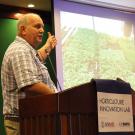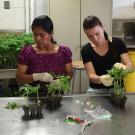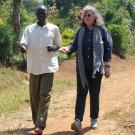
In many tropical countries, soilborne pathogens dramatically reduce tomato yields, impacting the livelihoods of rural families. The most limiting soilborne pathogen in the tropics is Ralstonia solanacearum, bacterial wilt.
Tomato grafting technology is a proven technology increasingly adapted worldwide to reduce risk of soilborne pathogens. Grafting produces a physical hybrid plant, with a rootstock chosen for its genetic ability to resist soilborne disease and a scion chosen based on fruit quality for commercialization. The technology is relatively simple, but has a major impact in increasing sustainability of vegetable production for small-scale growers. Grafting also creates a value-addition opportunity for entrepreneurial groups to specialize in the production and sale of grafted tomato seedlings.
In a previous project, a Horticulture Innovation Lab team led by Jim Nienhuis of the University of Wisconsin – Madison, identified tomato cultivars that are resistant to Begomoviruses and have good fruit quality.
Using these plants, the team conducts on-farm field trials with a women's group to identify optimal rootstock-scions combinations. The team also leads regional trainings in grafting technology, seed storage and small business management in cooperation with the Horticulture Innovation Lab's Regional Center at the Panamerican Agricultural School, Zamorano, in Honduras.



